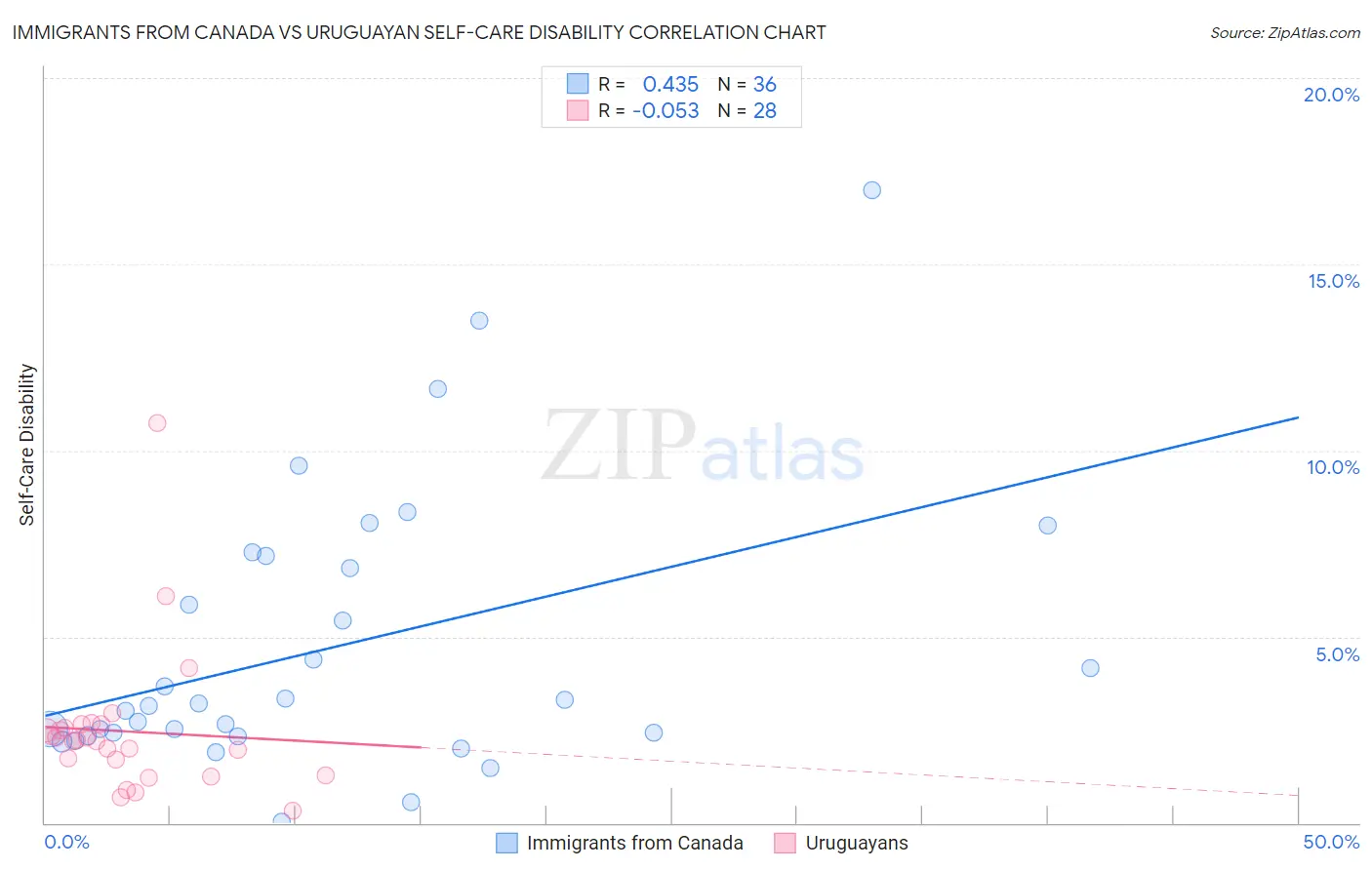Immigrants from Canada vs Uruguayan Self-Care Disability
COMPARE
Immigrants from Canada
Uruguayan
Self-Care Disability
Self-Care Disability Comparison
Immigrants from Canada
Uruguayans
2.4%
SELF-CARE DISABILITY
92.0/ 100
METRIC RATING
118th/ 347
METRIC RANK
2.4%
SELF-CARE DISABILITY
91.5/ 100
METRIC RATING
120th/ 347
METRIC RANK
Immigrants from Canada vs Uruguayan Self-Care Disability Correlation Chart
The statistical analysis conducted on geographies consisting of 458,661,407 people shows a moderate positive correlation between the proportion of Immigrants from Canada and percentage of population with self-care disability in the United States with a correlation coefficient (R) of 0.435 and weighted average of 2.4%. Similarly, the statistical analysis conducted on geographies consisting of 144,751,160 people shows a slight negative correlation between the proportion of Uruguayans and percentage of population with self-care disability in the United States with a correlation coefficient (R) of -0.053 and weighted average of 2.4%, a difference of 0.080%.

Self-Care Disability Correlation Summary
| Measurement | Immigrants from Canada | Uruguayan |
| Minimum | 0.045% | 0.33% |
| Maximum | 17.0% | 10.7% |
| Range | 17.0% | 10.4% |
| Mean | 4.7% | 2.5% |
| Median | 3.2% | 2.2% |
| Interquartile 25% (IQ1) | 2.4% | 1.5% |
| Interquartile 75% (IQ3) | 7.0% | 2.6% |
| Interquartile Range (IQR) | 4.6% | 1.1% |
| Standard Deviation (Sample) | 3.7% | 2.0% |
| Standard Deviation (Population) | 3.7% | 1.9% |
Demographics Similar to Immigrants from Canada and Uruguayans by Self-Care Disability
In terms of self-care disability, the demographic groups most similar to Immigrants from Canada are Immigrants from Sierra Leone (2.4%, a difference of 0.030%), Taiwanese (2.4%, a difference of 0.090%), Peruvian (2.4%, a difference of 0.11%), Northern European (2.4%, a difference of 0.15%), and Belgian (2.4%, a difference of 0.18%). Similarly, the demographic groups most similar to Uruguayans are Peruvian (2.4%, a difference of 0.030%), Immigrants from Sierra Leone (2.4%, a difference of 0.050%), Belgian (2.4%, a difference of 0.10%), Taiwanese (2.4%, a difference of 0.17%), and Immigrants from Nigeria (2.4%, a difference of 0.18%).
| Demographics | Rating | Rank | Self-Care Disability |
| Slovenes | 94.1 /100 | #109 | Exceptional 2.4% |
| Immigrants | Africa | 93.7 /100 | #110 | Exceptional 2.4% |
| Serbians | 93.6 /100 | #111 | Exceptional 2.4% |
| Scandinavians | 93.5 /100 | #112 | Exceptional 2.4% |
| South Americans | 93.2 /100 | #113 | Exceptional 2.4% |
| Immigrants | North Macedonia | 93.1 /100 | #114 | Exceptional 2.4% |
| Immigrants | Hong Kong | 93.1 /100 | #115 | Exceptional 2.4% |
| Northern Europeans | 92.9 /100 | #116 | Exceptional 2.4% |
| Taiwanese | 92.5 /100 | #117 | Exceptional 2.4% |
| Immigrants | Canada | 92.0 /100 | #118 | Exceptional 2.4% |
| Immigrants | Sierra Leone | 91.8 /100 | #119 | Exceptional 2.4% |
| Uruguayans | 91.5 /100 | #120 | Exceptional 2.4% |
| Peruvians | 91.3 /100 | #121 | Exceptional 2.4% |
| Belgians | 90.9 /100 | #122 | Exceptional 2.4% |
| Immigrants | Nigeria | 90.3 /100 | #123 | Exceptional 2.4% |
| Immigrants | North America | 90.2 /100 | #124 | Exceptional 2.4% |
| Immigrants | Morocco | 90.2 /100 | #124 | Exceptional 2.4% |
| Hmong | 89.9 /100 | #126 | Excellent 2.4% |
| Colombians | 89.7 /100 | #127 | Excellent 2.4% |
| Immigrants | Hungary | 89.6 /100 | #128 | Excellent 2.4% |
| Immigrants | Romania | 89.3 /100 | #129 | Excellent 2.4% |